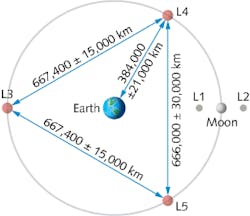INTERFEROMETRY: Lagrange: The first spaceborne gravitational-wave observatory?

A group of scientists has come up with a new space gravitational-wave-observatory design called Lagrange (LAser GRavitational-wave ANtenna at GEo-lunar Lagrange points) that would be half the cost of the now-abandoned Laser Interferometer Space Antenna (LISA). Lagrange combines technology from the LISA design with post-LISA improvements in UV and other LEDs, optics, and coatings.
The LISA space-based observatory was to have been developed by NASA and the European Space Agency (ESA); due to NASA budget cuts in 2011, the LISA project has been ended. Both NASA and ESA are looking at less expensive alternatives, with the ESA’s Next Gravitational-Wave Observatory (NGO) currently in the lead. But the time is ripe for alternate designs such as Lagrange, conceived by scientists from Stanford University (Palo Alto, CA), NASA Ames Research Center (Moffett Field, CA), King Abdulaziz City for Science and Technology (Riyadh, Saudi Arabia), CrossTrac Engineering (Sunnyvale, CA), Lockheed Martin Space Systems Co. (Palo Alto, CA), and SRI International (Menlo Park, CA).
Triangular arrangement
As does LISA, Lagrange consists of three spacecraft arrayed in a triangular "constellation" that forms a laser interferometer for gravitational-wave detection. LISA’s constellation would be placed in Earth’s orbit trailing Earth by 20° and with arms 5 × 109 m long; the Lagrange constellation would be much closer to us, placed at the L3, L4, and L5 Earth/Moon Lagrange points and with arms 6.7 × 108 m long (see figure). All three Lagrange spacecraft would be launched on a single Falcon 9 rocket.
Lagrange is designed to measure gravitational-wave perturbations in the 1 mHz to 1 Hz range at a strain sensitivity of 3 × 10-20. It includes a single gravitational reference sensor—a 70-mm-diameter spherical test mass (TM) rotating at 3 to 10 Hz (spun up to speed magnetically) and contained in a chamber so that it won’t be affected by drag. The interferometer is made up of a single 1 W laser linked via optical fiber to an optics bench (LISA had two lasers and two gravitational reference sensors); the laser frequency is stabilized using high-finesse optical cavities and/or iodine molecular clocks.
The reduction in hardware complexity and the geocentric orbit (which enables a cheaper launch and a higher communications bandwidth) make Lagrange potentially less expensive, easier to implement, and less risky than LISA.
Two possible configurations
The Lagrange interferometer must measure both the distance from the optics bench to the TM (which are both in the same spacecraft) and the distances between the spacecraft. The combined TM-to-TM one-way measurement accuracy is 8 pm Hz-1/2; the external interferometer handles Doppler shifts up to about 150 MHz due to distance changes between the spacecraft.
Two interferometer configurations are being considered. One is based on a double-sided polarization-selective diffraction grating that serves as both the main reference surface and a beamsplitter; this cuts down the number of optical components and separates the long- and short-arm interferometers with a single reference surface. The other (a back-up configuration) is more like LISA’s, with bonded components and more complexity.
The two-stage Lagrange telescope has a 5° "field of regard"; the optical path length of the entire system must be stable to 5 pm. Each spacecraft has two telescopes. Within the TM-containing spacecraft, superluminescent LEDs (SLEDs) monitor the position of the TM to a sensitivity of 1 nm Hz-1/2. To ensure that accumulation of electrical charge doesn’t cause position problems with the TM, a small RF mercury source with UV-LEDs for ionization can produce ions to neutralize charge.
Lagrange is designed to detect gravitational waves arising from mergers of massive black holes, mergers of stellar-mass compact objects with massive black holes, and orbits of stellar-mass binary systems (containing black holes or neutron stars) within the Milky Way.
REFERENCE
1. J.W. Conklin et al., arXiv:1111.5264v1 [astro-ph.IM] (Nov. 22, 2011).
About the Author
John Wallace
Senior Technical Editor (1998-2022)
John Wallace was with Laser Focus World for nearly 25 years, retiring in late June 2022. He obtained a bachelor's degree in mechanical engineering and physics at Rutgers University and a master's in optical engineering at the University of Rochester. Before becoming an editor, John worked as an engineer at RCA, Exxon, Eastman Kodak, and GCA Corporation.
